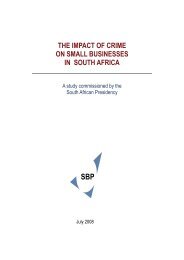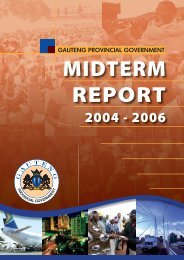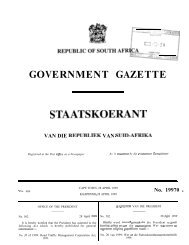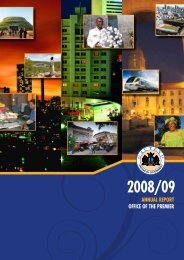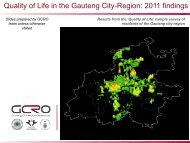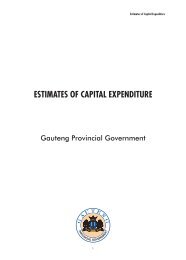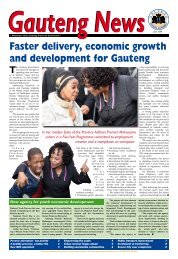the gauteng spatial development framework - Gauteng Online
the gauteng spatial development framework - Gauteng Online
the gauteng spatial development framework - Gauteng Online
Create successful ePaper yourself
Turn your PDF publications into a flip-book with our unique Google optimized e-Paper software.
THE BID-RENT MODELThe Bid-Rent Model is a computer (GIS) based model that provides a <strong>spatial</strong> depiction ofa range of relative values of an area. The model, as it has been developed for <strong>the</strong> currentprocess, draws on both desirability value, an approximate measure of <strong>development</strong> demand,and developability value, an indication of <strong>the</strong> overall suitability of an area for <strong>development</strong>.The basis of <strong>the</strong> Bid-Rent Model lies with 'grid' of 10m x 10m cells superimposed over <strong>the</strong>GSDF study area. Base data layers are filtered through this grid, resulting in each cell havinga specific value corresponding to each data layer.The resulting grid of cells, <strong>the</strong> basis of <strong>the</strong> model, serves as a basis for elaborating <strong>the</strong>proposed <strong>framework</strong> (structure/ lattice) as a whole (i.e. in terms of a specific <strong>development</strong>scenario or trend/strategy), or for specific <strong>development</strong> queries and analysis.Bid-rent <strong>the</strong>ory is used in urban economics to model urban activity patterns, and intensitiesof activity, according to <strong>the</strong> land value potential of a place as informed by how much acertain use would bid for a piece of land relative to <strong>the</strong> prices o<strong>the</strong>r land-uses would bid.Thus, at an epicentre of very high land value within a given <strong>spatial</strong> extent (notionally referredto as <strong>the</strong> Peak Land Value Intersection of any particular district), retail may typically bidextremely high at and over a very short distance from this epicentre; office uses may bidless but over a wider area from <strong>the</strong> epicentre; residential, in turn, may bid less but over amuch wider distance; and industrial, for its part, may bid least and be placed, by <strong>the</strong> propertyvalues, fur<strong>the</strong>st away from <strong>the</strong> epicentre. The resultant value-gradient from <strong>the</strong>se graphsrepresents what is referred to as <strong>the</strong> 'bid-rent curve' of a particular point or district.Effectively, <strong>the</strong> urban potential of any given point is indicated relative to its existing positionin <strong>the</strong> urban structure, its urban fundamentals (such as visibility and access), and <strong>the</strong> natureof <strong>the</strong> infrastructural investments in that area.This simply gives an indication of what might be expected, in urban performance terms,of an area in <strong>the</strong> existing circum-stances. It is <strong>the</strong>n possible to test, in 'if-<strong>the</strong>n' terms, what<strong>the</strong> result may be of various interventions into that area, say, in <strong>the</strong> form of a new highwayinterchange, or a new station or road link.ANNEXURE A: THE 5 GIS-BASED MODELSTHE ROLE OF THE MODELThe model is intended to guide <strong>the</strong> design process by suggesting areas of higher potentialenergy and intensity, and provide some direction to <strong>the</strong> determination of specific functionaluses, or <strong>the</strong> degree of mix of uses. It can also serve as a basis for longer-term strategies for<strong>the</strong> <strong>development</strong> and release of land.The Bid-Rent Model has been developed to describe an indicative urban potential of anygiven point within <strong>the</strong> GCR expressed, notionally, in 'bid-rent' terms. It is a model derivedto indicate relative urban <strong>development</strong> value ra<strong>the</strong>r than an indicative land value and shouldbe regarded in <strong>the</strong>se terms only.One is thus able, for example to identify those areas that may not be achieving <strong>the</strong>irurban potential at present, postulate why this may be, and test whe<strong>the</strong>r any particularprogramme of intervention would assist it in achieving more. Similarly, by cross- referencingwith <strong>the</strong> connectivity model, one may identify areas of dislocation and test <strong>the</strong> efficacy,indicative with <strong>the</strong> Bid-Rent Model, of various <strong>spatial</strong> interventions to rectify this.The diagram alongside reflects <strong>the</strong> overall structure of <strong>the</strong> Bid-Rent Model, showing <strong>the</strong>different layers utilised in formulating <strong>the</strong> cellular variables across <strong>the</strong> study area.As reflected in <strong>the</strong> diagram, <strong>the</strong>re are two distinct 'indices' around which <strong>the</strong> Bid-RentModel has been structured; one that defines an index of 'desirability' in <strong>the</strong> sense of creating115 GAUTENG SPATIAL DEVELOPMENT FRAMEWORK 2011 GAUTENG GROWTH AND DEVELOPMENT AGENCY



